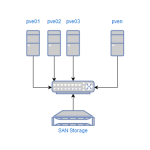Hi,
I have some bandwith problems for my backup. At now we are doing all backup with proxmox tool using nfs protocol but this take a lot of time ( about 14h for 20tb of vms ).
All of our storage are manage via 8Gb/s FC and LVM then we have 2 redundant gigabit networks, one dedicated for proxmox cluster management and the other one for vm traffic.
We expect to duplicate our vms in the next 4 months but there are some problem:
- FC not support Thin-LVM
- on LVM storage is not possible to do snaphot
- is not possible to have 28h of backup job
- we can't upgrade the gigabit management network to a 10Gb network for now ( budget reasons )
- we are already using gzip on backup jobs
- on LVM partition is not possible to store backup
And now the question:
I thought to install an HBA card on my backup NAS and publish the storage via FC then attach this storage to my Proxmox nodes and create a Shared directory over LVM and then do the backup job over 8Gb channel
We are testing differential backup in stage enviroment, but I need to find a solution for production eviroment asap.
I'm sure that my NAS support FC protocol but I don't sure if it's possible to create a shared directory over LVM in my case.
I have also read this articles:
- https://forum.proxmox.com/threads/use-local-lvm-as-directory.32924/
- https://pve.proxmox.com/wiki/LVM2#Create_a_extra_LV_for_.2Fvar.2Flib.2Fvz
- https://forum.proxmox.com/threads/incremental-backup-solution.39329/
- https://forum.proxmox.com/threads/backup-solutions.21443/
I'm using Proxmox VE 5.1-41
I have some bandwith problems for my backup. At now we are doing all backup with proxmox tool using nfs protocol but this take a lot of time ( about 14h for 20tb of vms ).
All of our storage are manage via 8Gb/s FC and LVM then we have 2 redundant gigabit networks, one dedicated for proxmox cluster management and the other one for vm traffic.
We expect to duplicate our vms in the next 4 months but there are some problem:
- FC not support Thin-LVM
- on LVM storage is not possible to do snaphot
- is not possible to have 28h of backup job
- we can't upgrade the gigabit management network to a 10Gb network for now ( budget reasons )
- we are already using gzip on backup jobs
- on LVM partition is not possible to store backup
And now the question:
I thought to install an HBA card on my backup NAS and publish the storage via FC then attach this storage to my Proxmox nodes and create a Shared directory over LVM and then do the backup job over 8Gb channel
We are testing differential backup in stage enviroment, but I need to find a solution for production eviroment asap.
I'm sure that my NAS support FC protocol but I don't sure if it's possible to create a shared directory over LVM in my case.
I have also read this articles:
- https://forum.proxmox.com/threads/use-local-lvm-as-directory.32924/
- https://pve.proxmox.com/wiki/LVM2#Create_a_extra_LV_for_.2Fvar.2Flib.2Fvz
- https://forum.proxmox.com/threads/incremental-backup-solution.39329/
- https://forum.proxmox.com/threads/backup-solutions.21443/
I'm using Proxmox VE 5.1-41
Last edited:


